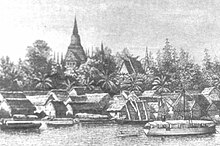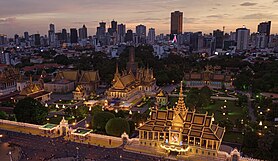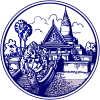
A | B | C | D | E | F | G | H | CH | I | J | K | L | M | N | O | P | Q | R | S | T | U | V | W | X | Y | Z | 0 | 1 | 2 | 3 | 4 | 5 | 6 | 7 | 8 | 9
Phnom Penh
ភ្នំពេញ | |
|---|---|
| |
From top, left to right: Independence Monument, Phnom Penh skyline, Skyscrapers in Khan Chamkar Mon district, National Museum of Cambodia, Khan Boeng Keng Kang district, Wat Phnom, View of Phnom Penh from the Mekong river | |
Nicknames:
| |
 | |
| Coordinates: 11°34′10″N 104°55′16″E / 11.56944°N 104.92111°E | |
| Country | |
| Settled | 5th century[2] |
| Founded | 1372 |
| Capital status | 1434–1497 |
| Capital re-established | 1865 |
| Named for | Wat Phnom and Lady Penh |
| Subdivisions | 14 khans[3] |
| Government | |
| • Type | Municipal council |
| • Governor | Khuong Sreng (CPP) |
| • National Assembly | 12 / 125
|
| Area | |
| • Total | 679 km2 (262 sq mi) |
| • Rank | 24th |
| Elevation | 11.89 m (39.01 ft) |
| Population (2024 census)[4] | |
| • Total | |
| • Rank | 1st |
| • Density | 3,361/km2 (8,700/sq mi) |
| • Rank | 1st |
| Demonyms |
|
| Time zone | UTC+07:00 (ICT) |
| Area code | +855 (023) |
| HDI (2019) | |
| Website | phnompenh |
| Phnom Penh | |
|---|---|
| Khmer name | |
| Khmer | ភ្នំពេញ UNGEGN: Phnum Pénh GD: Phnum Penh ALA-LC: Bhnaṃ Beñ IPA: [pʰnomˈpɨɲ] |
Phnom Penh (/pəˌnɒm ˈpɛn, ˌpnɒm -/;[6][7][8] Khmer: ភ្នំពេញ, Phnum Pénh [pʰnomˈpɨɲ], lit. 'Penh's Hill, Penh's Mountain') is the capital and most populous city of Cambodia. It has been the national capital since the French protectorate of Cambodia and has grown to become the nation's primate city and its economic, industrial, and cultural centre. Before Phnom Penh became capital city, Oudong was the capital of the country.
Phnom Penh succeeded Angkor Thom as the capital of the Khmer nation but was abandoned several times before being reestablished in 1865 by King Norodom. The city formerly functioned as a processing center, with textiles, pharmaceuticals, machine manufacturing, and rice milling. Its chief assets, however, were cultural. Institutions of higher learning included the Royal University of Phnom Penh (established in 1960 as Royal Khmer University), with schools of engineering, fine arts, technology, and agricultural sciences, the latter at Chamkar Daung, a suburb. Also located in Phnom Penh were the Royal University of Agronomic Sciences and the Agricultural School of Prek Leap.[9]
The city was nicknamed the "Pearl of Asia" for its early 20th century colonial French architecture, which included Art Deco works.[10] Phnom Penh, along with Siem Reap and Sihanoukville, are significant global and domestic tourist destinations for Cambodia. Founded in 1372, the city is noted for its historical architecture and attractions. It became the national capital in 1434 following the fall of Angkor, and remained so until 1497.[11] It regained its capital status during the French colonial era in 1865. There are a number of surviving colonial-era buildings scattered along the grand boulevards.
On the banks of the Tonlé Sap, Mekong, and Bassac Rivers, Phnom Penh is home to more than 2 million people, approximately 14% of the Cambodian population.[4] The Greater Phnom Penh area includes the nearby Ta Khmau city and some districts of Kandal province.[12]
The city has hosted numerous regional and international events, the most notable being the 2002, 2012, and 2022 ASEAN Summit, the 32nd Southeast Asian Games, and the 12th ASEAN Para Games. Phnom Penh will be the first Cambodian city and the second city in Southeast Asia to host the Asian Youth Games in 2029.[13]
Etymology
Phnom Penh (lit. "Penh's hill") takes its name from the present Wat Phnom (lit. "hill temple"), or from the ancient Funan Kingdom, which existed from the 1st to the 7th century AD in Southeast Asia and was the forerunner of the current Cambodian monarchy. Legend has it that in 1372, a wealthy widow named Penh found a Koki tree floating down the Tonlé Sap river after a storm.[14] Inside the tree were four bronze Buddha statues and a stone statue of Vishnu. Penh ordered villagers to raise the height of the hill northeast of her house and used the Koki wood to build a temple on the hill to house the four Buddha statues, and a shrine for the Vishnu image slightly lower down. The temple became known as Wat Phnom Daun Penh, which is now known as Wat Phnom, a small hill 27 metres (89 ft) in height.
Phnom Penh's former official name is Krong Chaktomuk Serei Mongkol (Khmer: ក្រុងចតុមុខសិរីមង្គល, lit. "city of Brahma's faces"), in its short form as Krong Chaktomuk (lit. "city of four faces"). Krong Chaktomuk is an abbreviation of the full name, given to it by King Ponhea Yat: Krong Chaktomuk Mongkol Sakal Kampuchea Thipadei Serei Theakreak Bavar Intabat Borei Roat Reach Seima Moha Nokor (Khmer: ក្រុងចតុមុខមង្គលសកលកម្ពុជាធិបតី សិរីធរបវរ ឥន្ទបត្តបុរី រដ្ឋរាជសីមាមហានគរ [kɾoŋ catomuk mɔŋkɔl sakɑl kampuciətʰəpaɗəj serəj tʰeareaɓɑːʋɑː ʔenteapat ɓorəj rɔətʰariəcsəjmaː mɔhaːnɔkɔː]). This loosely translates as "the place of four rivers that gives the happiness and success of the Khmer Kingdom, the highest leader as well as impregnable city of the God Indra of the great kingdom".[15]
History
The initial settlement of Phnom Penh is believed to have been established since the 5th century AD, according to the discovery of ancient kiln site in Choeung Ek commune of Dangkao district, southern part of central Phnom Penh in the early 2000s. Choeung Ek archaeological site was one of the largest kiln pottery center in Cambodia and the earliest known kiln sites in Southeast Asia to produce the ceremonial vessels known as kendi from 5th to 13th century.[16] Archaeologists stated that a large community is surrounded by a circular earthwork structure that is 740 metres in diameter and 4 metres high, built in the 11th century. In addition, there are remnants of other ancient village infrastructure, irrigation system, inscription, Shiva linga as well as an ancient brick temple foundation and its ornate remains which dated back to Funan era.[2][17]
First recorded a century after it is said to have taken place, the legend of the founding of Phnom Penh tells of a local woman, Penh (commonly referred to as Daun Penh (Lady Penh in Khmer), living at Chaktomuk, the future Phnom Penh. It was the late 14th century, and the Khmer capital was still at Angkor near Siem Reap 350 km (217 mi) to the north. Gathering firewood along the banks of the river, Lady Penh spied a floating koki tree in the river and fished it from the water. Inside the tree she found four Buddha statues and one of Vishnu.


The discovery was taken as a divine blessing, and to some a sign that the Khmer capital was to be brought to Phnom Penh from Angkor.[citation needed] To house the new-found sacred objects, Penh raised a small hill on the west bank of the Tonle Sap River and crowned it with a shrine, now known as Wat Phnom at the north end of central Phnom Penh. "Phnom" is Khmer for "hill" and Penh's hill took on the name of the founder, and the area around it became known after the hill.
Phnom Penh first became the capital of Cambodia after Ponhea Yat, king of the Khmer Empire, moved the capital from Angkor Thom after it was captured and destroyed by Siam a few years earlier. There is a stupa behind Wat Phnom that houses the remains of Ponhea Yat and the royal family as well as the remaining Buddhist statues from the Angkorean era. In the 17th century, Japanese immigrants also settled on the outskirts of present-day Phnom Penh.[18] A small Portuguese community survived in Phnom Penh until the 17th century, undertaking commercial and religious activity in the country.
Phnom Penh remained the royal capital for 73 years, from 1432 to 1505. It was abandoned for 360 years (from 1505 to 1865) by subsequent kings due to internal fighting between the royal pretenders. Later kings moved the capital several times and established their royal capitals at various locations in Tuol Basan (Srey Santhor), Pursat, Longvek, Lavear Em and Oudong.
It was not until 1866, under the reign of King Norodom I (1860–1904), the eldest son of King Ang Duong, who ruled on behalf of Siam, that Phnom Penh became the permanent seat of government and capital of Cambodia, and the current Royal Palace was built. Beginning in 1870, the French colonial authorities turned a riverside village into a city where they built hotels, schools, prisons, barracks, banks, public works offices, telegraph offices, law courts, and health services buildings. In 1872, the first glimpse of a modern city took shape when the colonial administration employed the services of French contractor Le Faucheur to construct the first 300 concrete houses for sale and rental to Chinese traders.
By the 1920s, Phnom Penh was known as the "Pearl of Asia", and over the next four decades, Phnom Penh continued to experience rapid growth with the building of railways to Sihanoukville and Pochentong International Airport (now Phnom Penh International Airport). Phnom Penh's infrastructure saw major modernisation under the rule of Sihanouk.
During the Vietnam War, Cambodia was used as a base by the People's Army of Vietnam and the Viet Cong, and thousands of refugees from across the country flooded the city to escape the fighting between their own government troops, the People's Army of Vietnam, the Viet Cong, the South Vietnamese and their allies, the Khmer Rouge, and American air strikes. By 1975, the population was 2–3 million, the bulk of whom were refugees from the fighting.[19] The Khmer Rouge cut off supplies to the city for more than a year before it fell on 17 April 1975.[14] Reports from journalists stated that the Khmer Rouge shelling "tortured the capital almost continuously", inflicting "random death and mutilation" on millions of trapped civilians.[20] The Khmer Rouge forcibly evacuated the entire city after taking it, in what has been described as a death march: François Ponchaud wrote that "I shall never forget one cripple who had neither hands nor feet, writhing along the ground like a severed worm, or a weeping father carrying his ten-year old daughter wrapped in a sheet tied around his neck like a sling, or the man with his foot dangling at the end of a leg to which it was attached by nothing but skin";[21] Jon Swain recalled that the Khmer Rouge were "tipping out patients from the hospitals like garbage into the streets....In five years of war, this is the greatest caravan of human misery I have seen".[22] All of its residents, including the wealthy and educated, were evacuated from the city and forced to do difficult labour on rural farms as "new people".[23] Tuol Sleng High School was taken over by Pol Pot's forces and was turned into the S-21 prison camp, where people were detained and tortured. Pol Pot sought a return to an agrarian economy and therefore killed many people perceived as educated, "lazy", spies, or political enemies. Many others starved to death as a result of failure of the agrarian society and the sale of Cambodia's rice to China in exchange for bullets and weaponry. The former high school is now the Tuol Sleng Genocide Museum, where Khmer Rouge torture devices and photos of their victims are displayed. Choeung Ek (the Killing Fields), 15 kilometers (9 mi) away, where the Khmer Rouge marched prisoners from Tuol Sleng to be murdered and buried in shallow pits, is also now a memorial to those who were killed by the regime.

The Khmer Rouge were driven out of Phnom Penh by the People's Army of Vietnam in 1979,[24] and people began to return to the city. Vietnam is historically a state with which Cambodia has had many conflicts, therefore this liberation was and is viewed with mixed emotions by the Cambodians. A period of reconstruction began, spurred by the continuing stability of government, attracting new foreign investment and aid by countries including France, Australia, and Japan. Loans were made from the Asian Development Bank and the World Bank to reinstate a clean water supply, roads and other infrastructure. The 1998 Census put Phnom Penh's population at 862,000;[25] and the 2008 census was 1.3 million.[26] By 2019, its population reached over 2.2 million, based on general population census.[4]
Geography
Phnom Penh is in the south-central region of Cambodia, and is fully surrounded by the Kandal province. The municipality is on the banks of the Tonlé Sap, Mekong, and Bassac Rivers. These rivers provide freshwater and other natural resources to the city. Phnom Penh and the surrounding areas consist of a typical flood plain area for Cambodia. Although Phnom Penh is at 11.89 metres (39 ft) above the river, monsoon season flooding is a problem, and the river sometimes overflows its banks.
The city, at 11°33′00″N 104°55′00″E / 11.55°N 104.91667°E (11°33' North, 104°55' East),[27] covers an area of 678.46 square kilometres (262 sq mi), with some 11,401 hectares (28,172 acres) in the municipality and 26,106 ha (64,509 acres) of roads. The agricultural land in the municipality amounts to 34.685 km2 (13 sq mi) with some 1.476 km2 (365 acres) under irrigation.
Climate
Phnom Penh has a tropical wet and dry climate (Köppen climate classification Aw). The climate is hot year-round with only minor variations. Temperatures typically range from 22 to 35 °C (72 to 95 °F) and weather is subject to the tropical monsoons. The southwest monsoon blows inland bringing moisture-laden winds from the Gulf of Thailand and Indian Ocean from May to November, sees high temperatures accompanied by high humidity. The dry season lasts from December to April; when overnight temperatures can drop to 22 °C (72 °F).
| Climate data for Phnom Penh (temperature: 1988–2013, extremes: 1906–2013) | |||||||||||||
|---|---|---|---|---|---|---|---|---|---|---|---|---|---|
| Month | Jan | Feb | Mar | Apr | May | Jun | Jul | Aug | Sep | Oct | Nov | Dec | Year |
| Record high °C (°F) | 36.1 (97.0) |
38.1 (100.6) |
40.0 (104.0) |
40.5 (104.9) |
40.0 (104.0) |
39.2 (102.6) |
37.2 (99.0) |
37.8 (100.0) |
35.5 (95.9) |
36.1 (97.0) |
34.4 (93.9) |
37.2 (99.0) |
40.5 (104.9) |
| Mean daily maximum °C (°F) | 31.6 (88.9) |
33.2 (91.8) |
34.6 (94.3) |
35.3 (95.5) |
34.8 (94.6) |
33.8 (92.8) |
32.9 (91.2) |
32.7 (90.9) |
32.2 (90.0) |
31.4 (88.5) |
31.1 (88.0) |
30.8 (87.4) |
32.9 (91.2) |
| Daily mean °C (°F) | 26.6 (79.9) |
28.0 (82.4) |
29.4 (84.9) |
30.2 (86.4) |
30.0 (86.0) |
29.2 (84.6) |
28.7 (83.7) |
28.5 (83.3) |
28.2 (82.8) |
27.2 (81.0) |
27.1 (80.8) |
26.3 (79.3) |
28.3 (82.9) |
| Mean daily minimum °C (°F) | 21.8 (71.2) |
22.8 (73.0) |
24.3 (75.7) |
25.5 (77.9) |
25.6 (78.1) |
24.9 (76.8) |
24.8 (76.6) |
24.6 (76.3) |
24.4 (75.9) |
24.2 (75.6) |
23.2 (73.8) |
21.9 (71.4) |
24.0 (75.2) |
| Record low °C (°F) | 12.8 (55.0) |
15.2 (59.4) |
19.0 (66.2) |
17.8 (64.0) |
20.6 (69.1) |
21.2 (70.2) |
20.1 (68.2) |
20.0 (68.0) |
21.1 (70.0) |
17.2 (63.0) |
16.7 (62.1) |
14.4 (57.9) |
12.8 (55.0) |
| Average precipitation mm (inches) | 12.1 (0.48) |
6.6 (0.26) |
34.8 (1.37) |
78.8 (3.10) |
118.2 (4.65) |
145.0 (5.71) |
162.1 (6.38) |
182.7 (7.19) |
270.9 (10.67) |
248.1 (9.77) |
120.5 (4.74) |
32.1 (1.26) |
1,411.9 (55.58) |
| Average rainy days (≥ 0.1 mm) | 1.2 | 1.1 | 3.4 | 6.8 | 15.9 | 17.0 | 18.1 | 18.3 | 21.5 | 19.3 | 10.2 | 4.5 | 137.3 |
| Average relative humidity (%) | 73 | 71 | 71 | 73 | 77 | 78 | 80 | 81 | 84 | 84 | 78 | 73 | 77 |
| Mean monthly sunshine hours | 260 | 226 | 267 | 240 | 202 | 192 | 143 | 174 | 129
Zdroj:https://en.wikipedia.org?pojem=Phnom-Penh Text je dostupný za podmienok Creative Commons Attribution/Share-Alike License 3.0 Unported; prípadne za ďalších podmienok. Podrobnejšie informácie nájdete na stránke Podmienky použitia.
Analytika
Antropológia Aplikované vedy Bibliometria Dejiny vedy Encyklopédie Filozofia vedy Forenzné vedy Humanitné vedy Knižničná veda Kryogenika Kryptológia Kulturológia Literárna veda Medzidisciplinárne oblasti Metódy kvantitatívnej analýzy Metavedy Metodika Text je dostupný za podmienok Creative
Commons Attribution/Share-Alike License 3.0 Unported; prípadne za ďalších
podmienok. www.astronomia.sk | www.biologia.sk | www.botanika.sk | www.dejiny.sk | www.economy.sk | www.elektrotechnika.sk | www.estetika.sk | www.farmakologia.sk | www.filozofia.sk | Fyzika | www.futurologia.sk | www.genetika.sk | www.chemia.sk | www.lingvistika.sk | www.politologia.sk | www.psychologia.sk | www.sexuologia.sk | www.sociologia.sk | www.veda.sk I www.zoologia.sk | ||||











